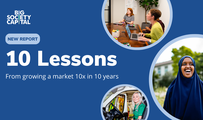When we published our market sizing report last year, we highlighted the diversity of the social impact investing market as well as its size and growth. By that, we mean that social impact investment isn’t a single financial product or investor. Rather, it is a collection of “investment ecosystems” which connect a range of enterprises and investors. What they have in common is that the enterprises are seeking to improve people’s lives and the investment can help them to grow their impact.
Our new strategy focuses on the four investment systems which we believe can create the most change. Those are Impact Venture, Social Lending, Social Outcomes and Social Property, to find out more about each individual system read here. As we look to the future, now seems a good time to reflect on what’s changed in those investment ecosystems and how that might impact on our ambitions for the future. And as we’ve just set a goal of at least doubling the size of the social impact investment market by 2025, it’s worth a stocktake on where we are starting from!
The first thing to highlight is that we’ve seen continued strong growth in social impact investment. Despite the many disruptions and uncertainties of the past 18 months, the social impact investment market has grown by 26% in the past year, to £6.4 billion. That’s nearly an eight-fold increase since 2011 – and the £1.2 billion new deals made in the year demonstrate the continued momentum across the market.
What’s fuelling that growth? While there has been strong growth across all systems including social property to social outcomes, I’m going to draw out a few themes that highlight how enterprises with a social purpose have continued to seek capital and find it from a growing pool of impact-driven investors – often enabled by partnerships across sectors.
Social Lending forms a large segment of the market, at £2.8 billion and is now 3x larger than in 2011. This system encompasses a range of debt tools, from small, unsecured loans to charity bonds and bank loans, that can be used by charities, social enterprises and social-purpose organisations to sustain and grow their impact. These enterprises are embedded in our communities and play a huge role in tackling the intersection of challenges that the UK faces, such as Net Zero, “levelling up” and post-COVID recovery.
We have 100,000 social enterprises which employ two million people and contribute £60 billion to the UK economy. This provides vital employment in left-behind towns and communities across the country and creates and sustains over 600,000 jobs in the most deprived areas. In addition, they bring deep expertise from years of experience of how to create solutions to these thorny challenges. Given the impact of the pandemic on many vulnerable people and communities, these organisations’ services and products have been even more essential – but the conditions in which they operate have been incredibly challenging.
The State of Social Enterprise Survey 2021, published by Social Enterprise UK, shows that in spite of the challenges of the pandemic, social enterprises are delivering economically, environmentally and socially. From data collected, 22% of social enterprises currently operate in the most deprived areas of the UK and 72% said that they were a Living Wage employer. Additionally, 44% grew their turnover the last year and 66% introduced a new product or service. [1]
In the past year, outstanding investments in Social Lending have grown by 21%. The scale and sustained growth of this market demonstrates the role social impact investment plays in connecting capital to organisations that support vulnerable people or reach into more underserved areas. For example, our deal level data shows that 63% of investments committed were into the 40% most deprived communities based on the Index of Multiple Deprivation[2].
Social banks such as Triodos, Unity Trust and Charity Bank continued to grow their loan books to over £2 billion, double the level of five years ago. This reflects their understanding and commitment to serving the needs of charities, social enterprises and mission-led organisations – which meant they were well positioned to support their existing borrowers and respond to emerging needs during 2020.
At the same time, blended loan funds like the Access Growth Fund and Nesta Arts & Culture Impact Fund have brought together grant and repayable finance so they can continue to meet the finance needs of smaller or earlier stage organisations. We’ve also seen powerful use of guarantees in the past year, in particular through the Resilience and Recovery Loan Fund and Community Investment Enterprise Facility, which used the Government’s Coronavirus Business Interruption Loan Scheme (CBILS) to get capital to over 80 charities and social enterprises and hundreds of SMEs when they needed it.
An example of one of these charities is St John Ambulance Cymru, whose services include ambulance and hospital transporting, as well as first aid training; alleviating the strain on the Welsh Ambulance Service. After its bank rejected a Coronavirus Business Interruption Loan Scheme (CBILS) application, the charity received a loan from the Resilience and Recovery Loan Fund which meant it did not have to spend its vital reserve investments.
Big Society Capital worked with Social Investment Business and other social investors to establish the £25 million fund to make CBILS loans available to charities and social enterprises. While these initiatives were in part borne of COVID-19 emergency support, we see real potential to continue to grow this market through sustained government guarantees and blended finance. These tools can help to connect capital with a more diverse group of organisations, who have often been overlooked or locked out due to the nature of previous options available. Additionally they support the growth of social purpose organisations looking to increase their impact, as well as strengthen their business foundations.
Another area that is gaining traction is impact venture, as new entrants into the impact market recognise the role of tech-enabled models in tackling social challenges such as mental health and financial inclusion. An organisation who is doing just this, is Wagestream; whose financial wellbeing app is helping to eliminate the invisible, urgent problem of financial stress by allowing staff to access pay as and when they earn it. This helps to reduce reliance on predatory forms of credit and helps employees to build up their savings and financial resilience. Wagestream received an investment from the £10 million Fair by Design Fund, managed by Ascension, which Big Society Capital invested £6 million into.
Dedicated impact venture funds now account for 10% of the market and saw growth of 41% over the past year. There are now almost 30 impact managers in our data set – with recent significant fund launches by leading venture managers such as Balderton demonstrating the power of impact as a source of value.
Partnerships have been essential for delivering this growth – and will be crucial for achieving our ambitions for future scale of impact. These partnerships often spanned social, public and private sectors, as well as philanthropic organisations, who helped initiatives such as the Resilience and Recovery Loan Fund, Women in Safe Homes fund and Everyone In get off the ground.
Our strategy to 2025 is informed by everything we have learned over the past decade. Now is the time to take social impact investment to the next level, creating even greater social change.
We are part of a movement with real momentum. Please get in touch to find out more.
[1] Based on ‘No Going Back – State of Social Enterprise Survey 2021’ published by Social Enterprise UK. See more here
[2] This is based on our Deal-Level Data, which is a subset of our deal flow figure for which we get granular deal level data. This statistic is based on cumulative data over time, starting from 2012 up till the end of 2020. See more here










